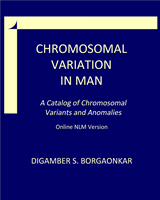NCBI Bookshelf. A service of the National Library of Medicine, National Institutes of Health.
Borgaonkar DS. Chromosomal Variation in Man: A Catalog of Chromosomal Variants and Anomalies: Online NLM Version [Internet]. Bethesda (MD): National Center for Biotechnology Information (US); 1975-.

Chromosomal Variation in Man: A Catalog of Chromosomal Variants and Anomalies: Online NLM Version [Internet].
Show details- Aladhami S M S, Gould C P, Muhammad F A.: A new inherited interstitial deletion of the distal long arm of chromosome 4. Hum. Hered. 50:146-150, 2000. [PubMed: 10799975]Proband=46,XY,der del(4)(q32q33)mat.Mother had slanting palpebral fissures, absence of glabellar angle, wide nasal bridge, micrognathia, and obesity. She was her father''s only child. The proband was 12 years old with learning difficulties, and behaior problems, obesity, breast hypertrophy and bilateral slipped capital femoral epiphysis.Aberration: Interstitial deletionChromosomal Aneuploidy: 4q-
- Aurias A, Prieur M, Dutrillaux B, Lejeune J: Systematic analysis of 95 reciprocal translocations of autosomes. Hum. Genet. 45:259-282, 1978. [PubMed: 738728]Patient I.P. No. 15860 in this report.46,XX,t(4;21)(q32;q222).&"46,XX,t(4pter -> 4q32::21q222 -> 21qter;21pter -> 21q222;4q32 -> 4qter)."&"47,XX,+der(21)t(4;21)(q32;q222)mat."Aberration: Reciprocal translocationPositive band
- Baccichetti C, Tenconi R, Anglani F, Zacchello F: Trisomy 4q32 to 4qter due to a maternal 4/21 translocation. J. Med. Genet. 12:425-427, 1975. [PMC free article: PMC1013328] [PubMed: 1219127]Case 250366 (III-3) in this report.46,XX,-21,+der(21)t(4;21)(q32;q22)mat.&Difficulties in delineating a syndrome associated with trisomy of this segment have been pointed out.Case II-6 in this report.46,XX,t(4;21)(q32;q22).&"46,XX,t(4;21)(4pter -> 4q32::21q22 -> 21qter;21pter -> 21q22::4q32 -> 4qter)."&Parents of II-6 had normal karyotypes.Aberration: Reciprocal translocationPositive band
- Boue A, Gallano P: A collaborative study of the segregation of inherited chromosome structural rearrangements in 1356 prenatal diagnoses. Prenat. Diag. 4:45-67, 1984. [PubMed: 6463033]t(4;8)(q32;q21).Aberration: Reciprocal translocationPositive band
- Byatt S A, Baker E, Richards R I, Roberts C, Smith A.: Unbalanced t(4;11)(q32;q23) in a 34-year-old man with manifestations of distal monosomy 11q and trisomy 4q syndromes. AJMG 70:357-360, 1997. [PubMed: 9182774]Father=46,XY,t(4;11)(q32;q23.3).,Patient=46,XY,der(11)t(4;11)(11pter->11q23.3::4q32->4qter)pat.The patient had minor facial anomalies, abnormal head shape, cryptorchidism, hirsutism, renal disease, heart disease, musculskeletal anomalies, and mental retardation.Patients two sibs also had the same translocation.Aberration: Reciprocal translocationChromosomal Aneuploidy: 4q+;11q-
- Cook P J L, Lindenbaum R H, Salonen R, de la Chapelle A, Daker M G, Buckton K E, Noades J E, Tippett P: The MNSs blood groups of families with chromosome 4 rearrangements. Ann. Hum. Genet. 45:39-47, 1981. [PubMed: 7316476]
McDermott A, Poulding R, Creery D: "Cri-du-chat syndrome in a child with a 46,XX,der(5),t(4;5)(q32;p14)pat karyotype." Hum. Genet. 39:109-112, 1977. [PubMed: 924437]Patient died at 8 months of age.46,XY,t(4;5)(q32;p14).&"46,XY,t(4;5)(4pter -> 4q32::5p14 -> 5pter;5qter -> 5p14::4q32 -> 4qter)."&"46,XY,der(5)t(4;5)(q32;p14)pat."&MNSs loci appear -> be in the segment between 4q28 -> 4q31.Aberration: Reciprocal translocationMIM#: 111300,111740Index Terms: Cri-du-Chat syndrome (Cat's cry syndrome)Positive band - Fryns J P, Timmermans J, Hoedemaekey J, Emmery L, van den Berghe H: Pierre-Robin anomalad, moderate mental retardation and distal 4q deletion. Ann. Genet. 24:187-188, 1981. [PubMed: 6974535]Patient S. H. was 12 years old. No other members of the family were karyotyped.46,XX,del(4)(pter -> q32:).Aberration: Terminal deletionMIM#: 172880Index Terms: Pierre Robin syndromePositive band
- Keeling S L, Lee-Jones L, Thompson P.: Interstitial deletion 4q32-34 with ulnar deficiency: 4q33 may be the critical region in 4q terminal deletion syndrome. AJMG 99:94-98, 2001. [PubMed: 11241465]46,XY,del(4)(q32q34)de novoThe infant had Robin sequence, mild developmental delay; a left ulnar ray defect with absent ulna and associated metacarpals, carpals and phalanges; and a right ulnar nerve hypoplasia.Aberration: Interstitial deletionMIM#: 172880Chromosomal Aneuploidy: 4q-Index Terms: Robin sequenceNo band
- Lin A E, Garver K L, Diggans G, Clemens M, Wenger S L, Steele M W, Jones M C, Israel J: Interstitial and terminal deletions of the long arm of chromosome 4: further delineation of phenotypes. AJMG 31:533-548, 1988. [PubMed: 3067575]Patient 2.46,XX,del(4)(pter -> q32:).The authors have reviewed data on 45 patients. Deletions of q31 and q32->qter produce an identifiable phenotype consisting of abnormal skull shape, hypertelorism, cleft palate, apparently low-set abnormal pinnae, short nose with abnormal bridge, virtually pathognomic pointed fifth finger and nail, congenital heart and genitourinary defects, moderate-severe mental retardation, poor postnatal growth, and hypotonia.Patient 3.46,XY,-4,+der(4),t(4;11)(4pter -> 4q32::11p15.5 -> 11pter)pat.&"Father and sister:46,XY or XX,t(4;11)(q32;p15.5)pat."Aberration: TD,RTChromosomal Aneuploidy: 4q-Positive band
- Neri G, Serra A, Campana M, Tedeschi B: Reproductive risks for translocation carriers: cytogenetic study and analysis of pregnancy outcome in 58 families. AJMG 16:535-561, 1983. [PubMed: 6660248]Sibship C.F. in this report.t(4;14)(q32;q32).Aberration: Reciprocal translocationPositive band
- Rivera H, Figuera L E, Vasquez A I.: Translocation/duplication of 9p onto a duplicated 4q. Genet. Counsel. 3:201-203, 1992. [PubMed: 1472355]Patient R.I. was 5 months old with a severe heart defect.46,XX,t(4;9)(4pter->4q32::4q35->4q32::4q32->4q35::9p22->9pter).Aberration: DU,STChromosomal Aneuploidy: 4q+;9p+
- Uchida I A, Freeman V, In, Daniel A, Hook E B, Wulf G: Risks of unbalanced progeny at amniocentesis to carriers of chromosome rearrangements: data from United States and Canadian laboratories. AJMG 33:14-53, 1989. [PubMed: 2750783]Observation No. 432.46,XY,t(4;7)(q32;q31)mat.Aberration: Reciprocal translocationPositive band
- Uehara S, Takabayashi T, Okamura K, Yajima A: The outcome of pregnancy and prenatal chromosomal diagnosis of fetuses in couples including a translocation carrier. Prenat. Diag. 12:1009-1018, 1992. [PubMed: 1287636]46,XX,t(4;10)(q32;p15).&46,XX,+4q.The karyotype nomenclature of the fetus is not in conformity with ISCN (ie is it 4q+ or is it partial trisomy for 4q?).Aberration: Reciprocal translocationPositive band
- Wenger S L, Steele M W, Boone L Y, Lenkey S G, Cummins J H, Chen X Q.: "Balanced" karyotypes in six abnormal offspring of balanced reciprocal translocation normal carrier parents. AJMG 55: 47-52, 1995. [PubMed: 7702096]It is commented that newborn infants inheriting a seemingly "balanced" karyotype from a normal parent with a balanced reciprocal translocation may still be at an increased risk of being malformed and/or developmentally delayed because of submicroscopic chromosomal imbalances. It is proposed that autosomal fragile sites are unstable areas which predispose to breaks and unequal crossing over near the fragile site breakpoints creating minute duplications and deletions.46,XY,-4,+der(4)t(4;11)(q32;p15.5)pat.Aberration: Reciprocal translocationChromosomal Aneuploidy: 4q-;11p+Positive band
- 04q320 - Chromosomal Variation in Man04q320 - Chromosomal Variation in Man
Your browsing activity is empty.
Activity recording is turned off.
See more...